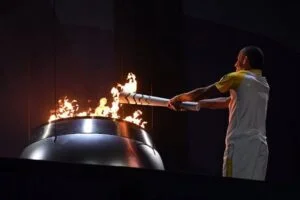In the article “Relay race” we will talk about the team discipline in sports, about its types and features when passing, talk about the Olympic torch relay.
#Relay #SportRelay #RelayRace #Sport
Every schoolboy knows what a relay race is. It is an exciting competition, which allows you to show team spirit, because the victory depends on the common efforts of the participants. The relay races are fun to participate in and to cheer on your team. Not without reason the relay is part of the Olympic program since 1900 in swimming, since 1908 in athletics, and since 1936 the ski relay became an Olympic event.
As we understand it, the relay cannot be tied to any one sport. In addition to those disciplines that we have listed, the relay is also held in biathlon, speed skating, orienteering. And the very first relay was equestrian, and it had nothing to do with sports.
A horse-drawn relay was a type of urgent postal delivery. The messengers on horseback replaced each other on the way, passing important letters and messages. Later the concept reached the sport as well. The most famous and varied relays in athletics. World Championships, European Championships and the Olympics include the classic relays for runners, 4 * 100 meters, i.e. when each of the team runs a hundred meters, and 4 * 400 meters.
However, there are several types not so common, such as the Swedish relay, in which each participant runs a different distance for each stage (100*200*300*400). Relays with hurdles on highways and cross-country, and in some countries a type of “ekiden” is popular, a relay that is run over marathon distances.
The relay is a team discipline, and success in the competition is shared equally by all team members. The athletes themselves admit that when working as a team, special attention must be paid to the observance of the rules, as a mistake by one athlete will let the other participants down.

About the rules. Each sport has its own specifics. In track and field, runners move from leg to leg by passing a stick or ribbon. In skiing, athletes have their hands full of ski poles, so the handoff is a simple touch of the hand. Swimmers, on the other hand, touch the board with their hands.
It seems simple, the main thing is to run the fastest part of the course and pass the baton to the next team member. However, this is the main point of the discipline. In track and field athletes, the main rules relate to just the correct passing of the baton.
The passing must take place within a special corridor. To hold the stick, athletes may not use a sticky compound or gloves. Separately, it is stipulated that athletes may not be obstructed during the relay race. If someone loses a wand or passes it outside the corridor, the team loses points.
Clear passing of the baton is practiced by runners through long training sessions, especially in sprint relay races. There are two ways to pass the baton: from bottom to top and from top to bottom. This is done by running slowly and quickly at the signal of the transferring participant.

Over the years, relay coaches have developed their own tricks and strategies for team preparation. The order in which the runners participate in the various stages is determined in advance. Usually they distribute them so that the strongest athlete runs last.
The relay is interesting in biathletes. Each of the 4 members of the team must pass their part of the track, the men’s is 7.5 kilometers, women’s is 6 kilometers, and shoot for two strikes, and then pass the baton. If a competitor fails to hit the target, he runs a penalty lap of 150 meters, so that the fastest and most accurate team wins.
There is a special kind of relay that we want to write about. We’re talking about the Olympic Torch Relay. There are no winners or losers in this type of relay, and the Olympic flame is passed on instead of a baton.

It was first held in 1936. At that time, the torch, lit in Olympia, was taken to Berlin, and more than 3,000 runners participated in the action. Since then, no Olympics has taken place without such a relay, and its route is developed by the organizing committee of the games and the national Olympic committee of the country where the games will be held.
A few months before the opening of the Olympic Games, the lighting ceremony is held in Olympia (Greece), after which the flame is delivered to the host city. Famous cultural and social figures, athletes take part in the relay, they carry the torch, passing it to each other. Sometimes host countries apply creativity in passing the torch, using unusual forms of the baton. For example, divers in the ocean, mountain climbers in the mountains, astronauts in space.

As a rule, the last torchbearer of the relay is a famous and popular athlete of the host country. At the opening ceremony, he lights the flame in the bowl, which continues to burn until the next ceremony – the closing of the games. In most cases, the name of the athlete is not disclosed in advance to maintain the intrigue of the ceremony itself.
In 2004, the first worldwide Olympic torch relay took place. The Games took place in Athens. The baton was held for 78 days and was attended by 11,300 torchbearers. During that time, they covered a distance of 78,000 kilometers. Now the IOC (International Olympic Committee) decided to limit the Olympic torch relay to the host country.
What seemed to be so difficult about a relay race? You run up to a runner, pass him the baton, he starts, and you rest. In fact, passing the baton is not an easy process.
If you look closely at relay competitions, you’ll notice that the runner who has to take the baton starts running before he or she even receives the baton. This is done to save precious seconds.
Experienced coaches calculate exactly where a runner should be, at what moment to start in order to achieve maximum speed at the moment of passing the baton, and also so that this transfer takes place exactly in the corridor zone. It is this knowledge of the laws of physics that helps athletes and their coaches develop an effective strategy that allows them to get the most out of their athletes.

Since relay races are not an independent sport, there are no sections that train participants, but they are not needed either. Relays are part of training in many sports. Quite often they are also found at competitions in general education and sports schools.
For the duration of the competition, young athletes become part of the relay team, and this is an opportunity to practice skills that in the future can lead to a world championship or the Olympics.
You can develop qualities that are useful in relay races by yourself. For example, learn to run with acceleration. Since the most popular relay races take place in short-distance running, sprinters, i.e. short-distance runners, are the easiest to get into. Relay team training is also part of sprinter training. That’s as far as track and field is concerned, but relays are also for skiers, swimmers, and speed skaters.
Schools that train the appropriate athletes are very likely to include relays in the competition program as well. In short, whichever discipline you choose, you have every chance to try your hand at a team sport that allows you to discover your potential and feel how overall success is made up of the achievements of each participant.
Olympic torch relay race
FAQs
What is a relay race?
The relay race is an integral part of a sports discipline in which each team member must complete his stage as quickly as possible and give his partner the right to go the distance. The fastest team wins the relay, and success is equally shared by all team members.
What is a counter relay race?
The counter relay is a kind of fun relay race for children, in which the team is divided into two equal subgroups, and the participants run towards each other. For example, a team of 8 people was divided into two subgroups of 4 people each. The subgroups are arranged in a column one at a time and placed opposite each other at a distance of 10 meters. The first participant of the first subgroup runs 10 meters and passes the baton to the first participant of the second subgroup, and he takes the last place in the column. The relay ends when both subgroups switch places, as if in a mirror image.
What relay races exist in swimming?
At the World Swimming Championships and Summer Olympics in the Games program includes 5 relay types: 4 * 100 meters (freestyle, men and women), 4 * 200 meters (freestyle, men and women) Combined 4 * 100 meters (in each event a different style, men and women); Mixed 4 * 100 meters (freestyle, men + women), Mixed Combined 4 * 100 meters (in each event a different style, men and women).









